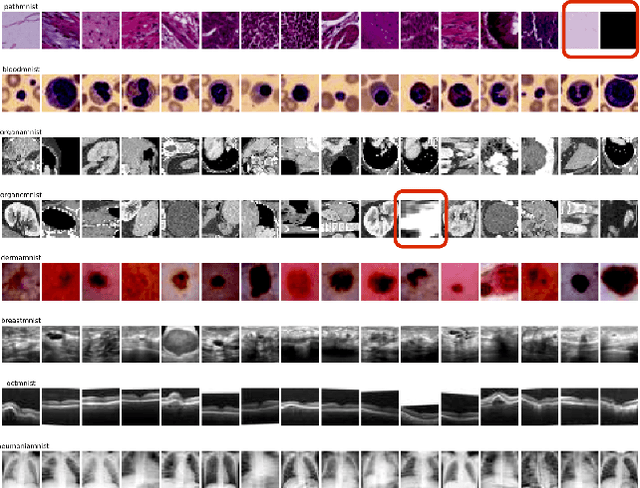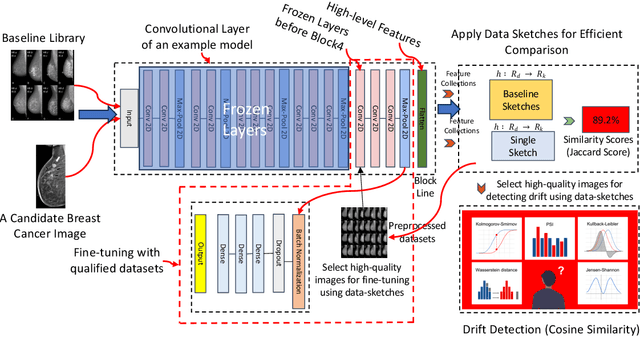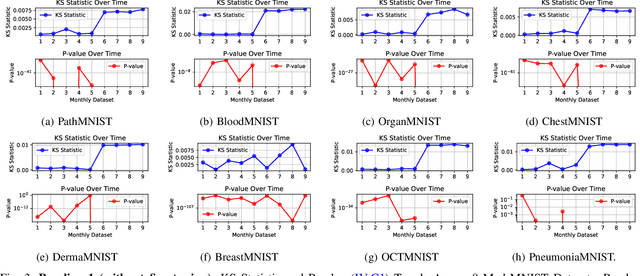Yusen Wu
ZenFlow: Enabling Stall-Free Offloading Training via Asynchronous Updates
May 18, 2025Abstract:Fine-tuning large language models (LLMs) often exceeds GPU memory limits, prompting systems to offload model states to CPU memory. However, existing offloaded training frameworks like ZeRO-Offload treat all parameters equally and update the full model on the CPU, causing severe GPU stalls, where fast, expensive GPUs sit idle waiting for slow CPU updates and limited-bandwidth PCIe transfers. We present ZenFlow, a new offloading framework that prioritizes important parameters and decouples updates between GPU and CPU. ZenFlow performs in-place updates of important gradients on GPU, while asynchronously offloading and accumulating less important ones on CPU, fully overlapping CPU work with GPU computation. To scale across GPUs, ZenFlow introduces a lightweight gradient selection method that exploits a novel spatial and temporal locality property of important gradients, avoiding costly global synchronization. ZenFlow achieves up to 5x end-to-end speedup, 2x lower PCIe traffic, and reduces GPU stalls by over 85 percent, all while preserving accuracy.
Implementing Long Text Style Transfer with LLMs through Dual-Layered Sentence and Paragraph Structure Extraction and Mapping
May 11, 2025Abstract:This paper addresses the challenge in long-text style transfer using zero-shot learning of large language models (LLMs), proposing a hierarchical framework that combines sentence-level stylistic adaptation with paragraph-level structural coherence. We argue that in the process of effective paragraph-style transfer, to preserve the consistency of original syntactic and semantic information, it is essential to perform style transfer not only at the sentence level but also to incorporate paragraph-level semantic considerations, while ensuring structural coherence across inter-sentential relationships. Our proposed framework, ZeroStylus, operates through two systematic phases: hierarchical template acquisition from reference texts and template-guided generation with multi-granular matching. The framework dynamically constructs sentence and paragraph template repositories, enabling context-aware transformations while preserving inter-sentence logical relationships. Experimental evaluations demonstrate significant improvements over baseline methods, with structured rewriting achieving 6.90 average score compared to 6.70 for direct prompting approaches in tri-axial metrics assessing style consistency, content preservation, and expression quality. Ablation studies validate the necessity of both template hierarchies during style transfer, showing higher content preservation win rate against sentence-only approaches through paragraph-level structural encoding, as well as direct prompting method through sentence-level pattern extraction and matching. The results establish new capabilities for coherent long-text style transfer without requiring parallel corpora or LLM fine-tuning.
Weakly Supervised Convolutional Dictionary Learning with Shared and Discriminative Components for Classification
Mar 11, 2025Abstract:In today's data-driven landscape spanning finance, government, and healthcare sectors, the exponential growth of information necessitates robust solutions for secure storage, efficient dissemination, and fine-grained access control. Convolutional dictionary learning emerges as a powerful approach for extracting meaningful representations from complex data. This paper presents a novel weakly supervised convolutional dictionary learning framework that incorporates both shared and discriminative components for classification tasks. Our approach leverages limited label information to learn dictionaries that capture common patterns across classes while simultaneously highlighting class-specific features. By decomposing the learned representations into shared and discriminative parts, we enhance both feature interpretability and classification performance. Extensive experiments across multiple datasets demonstrate that our method outperforms state-of-the-art approaches, particularly in scenarios with limited labeled data. The proposed framework offers a promising solution for applications requiring both effective feature extraction and accurate classification in weakly supervised settings.
Game Theory Meets Large Language Models: A Systematic Survey
Feb 13, 2025Abstract:Game theory establishes a fundamental framework for analyzing strategic interactions among rational decision-makers. The rapid advancement of large language models (LLMs) has sparked extensive research exploring the intersection of these two fields. Specifically, game-theoretic methods are being applied to evaluate and enhance LLM capabilities, while LLMs themselves are reshaping classic game models. This paper presents a comprehensive survey of the intersection of these fields, exploring a bidirectional relationship from three perspectives: (1) Establishing standardized game-based benchmarks for evaluating LLM behavior; (2) Leveraging game-theoretic methods to improve LLM performance through algorithmic innovations; (3) Characterizing the societal impacts of LLMs through game modeling. Among these three aspects, we also highlight how the equilibrium analysis for traditional game models is impacted by LLMs' advanced language understanding, which in turn extends the study of game theory. Finally, we identify key challenges and future research directions, assessing their feasibility based on the current state of the field. By bridging theoretical rigor with emerging AI capabilities, this survey aims to foster interdisciplinary collaboration and drive progress in this evolving research area.
Improving VTE Identification through Language Models from Radiology Reports: A Comparative Study of Mamba, Phi-3 Mini, and BERT
Aug 16, 2024



Abstract:Venous thromboembolism (VTE) is a critical cardiovascular condition, encompassing deep vein thrombosis (DVT) and pulmonary embolism (PE). Accurate and timely identification of VTE is essential for effective medical care. This study builds upon our previous work, which addressed VTE detection using deep learning methods for DVT and a hybrid approach combining deep learning and rule-based classification for PE. Our earlier approaches, while effective, had two major limitations: they were complex and required expert involvement for feature engineering of the rule set. To overcome these challenges, we utilize the Mamba architecture-based classifier. This model achieves remarkable results, with a 97\% accuracy and F1 score on the DVT dataset and a 98\% accuracy and F1 score on the PE dataset. In contrast to the previous hybrid method on PE identification, the Mamba classifier eliminates the need for hand-engineered rules, significantly reducing model complexity while maintaining comparable performance. Additionally, we evaluated a lightweight Large Language Model (LLM), Phi-3 Mini, in detecting VTE. While this model delivers competitive results, outperforming the baseline BERT models, it proves to be computationally intensive due to its larger parameter set. Our evaluation shows that the Mamba-based model demonstrates superior performance and efficiency in VTE identification, offering an effective solution to the limitations of previous approaches.
Efficient Data-Sketches and Fine-Tuning for Early Detection of Distributional Drift in Medical Imaging
Aug 15, 2024



Abstract:Distributional drift detection is important in medical applications as it helps ensure the accuracy and reliability of models by identifying changes in the underlying data distribution that could affect diagnostic or treatment decisions. However, current methods have limitations in detecting drift; for example, the inclusion of abnormal datasets can lead to unfair comparisons. This paper presents an accurate and sensitive approach to detect distributional drift in CT-scan medical images by leveraging data-sketching and fine-tuning techniques. We developed a robust baseline library model for real-time anomaly detection, allowing for efficient comparison of incoming images and identification of anomalies. Additionally, we fine-tuned a vision transformer pre-trained model to extract relevant features using breast cancer images as an example, significantly enhancing model accuracy to 99.11\%. Combining with data-sketches and fine-tuning, our feature extraction evaluation demonstrated that cosine similarity scores between similar datasets provide greater improvements, from around 50\% increased to 100\%. Finally, the sensitivity evaluation shows that our solutions are highly sensitive to even 1\% salt-and-pepper and speckle noise, and it is not sensitive to lighting noise (e.g., lighting conditions have no impact on data drift). The proposed methods offer a scalable and reliable solution for maintaining the accuracy of diagnostic models in dynamic clinical environments.
Hummer: Towards Limited Competitive Preference Dataset
May 21, 2024Abstract:Preference datasets are essential for incorporating human preferences into pre-trained language models, playing a key role in the success of Reinforcement Learning from Human Feedback. However, these datasets often demonstrate conflicting alignment objectives, leading to increased vulnerability to jailbreak attacks and challenges in adapting downstream tasks to prioritize specific alignment objectives without negatively impacting others. In this work, we introduce a novel statistical metric, Alignment Dimension Conflict, to quantify the degree of conflict within preference datasets. We then present \texttt{Hummer} and its fine-grained variant, \texttt{Hummer-F}, as innovative pairwise preference datasets with reduced-conflict alignment objectives. \texttt{Hummer} is built based on UltraFeedback and is enhanced by AI feedback from GPT-4, marking as the first preference dataset aimed at reducing the competition between alignment objectives. Furthermore, we develop reward models, HummerRM and HummerRM-F, which employ a hybrid sampling approach to balance diverse alignment objectives effectively. This sampling method positions HummerRM as an ideal model for domain-specific further fine-tuning and reducing vulnerabilities to attacks.
A Joint Gradient and Loss Based Clustered Federated Learning Design
Nov 22, 2023



Abstract:In this paper, a novel clustered FL framework that enables distributed edge devices with non-IID data to independently form several clusters in a distributed manner and implement FL training within each cluster is proposed. In particular, our designed clustered FL algorithm must overcome two challenges associated with FL training. First, the server has limited FL training information (i.e., the parameter server can only obtain the FL model information of each device) and limited computational power for finding the differences among a large amount of devices. Second, each device does not have the data information of other devices for device clustering and can only use global FL model parameters received from the server and its data information to determine its cluster identity, which will increase the difficulty of device clustering. To overcome these two challenges, we propose a joint gradient and loss based distributed clustering method in which each device determines its cluster identity considering the gradient similarity and training loss. The proposed clustering method not only considers how a local FL model of one device contributes to each cluster but also the direction of gradient descent thus improving clustering speed. By delegating clustering decisions to edge devices, each device can fully leverage its private data information to determine its own cluster identity, thereby reducing clustering overhead and improving overall clustering performance. Simulation results demonstrate that our proposed clustered FL algorithm can reduce clustering iterations by up to 99% compared to the existing baseline.
Enabling Quartile-based Estimated-Mean Gradient Aggregation As Baseline for Federated Image Classifications
Sep 21, 2023



Abstract:Federated Learning (FL) has revolutionized how we train deep neural networks by enabling decentralized collaboration while safeguarding sensitive data and improving model performance. However, FL faces two crucial challenges: the diverse nature of data held by individual clients and the vulnerability of the FL system to security breaches. This paper introduces an innovative solution named Estimated Mean Aggregation (EMA) that not only addresses these challenges but also provides a fundamental reference point as a $\mathsf{baseline}$ for advanced aggregation techniques in FL systems. EMA's significance lies in its dual role: enhancing model security by effectively handling malicious outliers through trimmed means and uncovering data heterogeneity to ensure that trained models are adaptable across various client datasets. Through a wealth of experiments, EMA consistently demonstrates high accuracy and area under the curve (AUC) compared to alternative methods, establishing itself as a robust baseline for evaluating the effectiveness and security of FL aggregation methods. EMA's contributions thus offer a crucial step forward in advancing the efficiency, security, and versatility of decentralized deep learning in the context of FL.
Improving VTE Identification through Adaptive NLP Model Selection and Clinical Expert Rule-based Classifier from Radiology Reports
Sep 21, 2023



Abstract:Rapid and accurate identification of Venous thromboembolism (VTE), a severe cardiovascular condition including deep vein thrombosis (DVT) and pulmonary embolism (PE), is important for effective treatment. Leveraging Natural Language Processing (NLP) on radiology reports, automated methods have shown promising advancements in identifying VTE events from retrospective data cohorts or aiding clinical experts in identifying VTE events from radiology reports. However, effectively training Deep Learning (DL) and the NLP models is challenging due to limited labeled medical text data, the complexity and heterogeneity of radiology reports, and data imbalance. This study proposes novel method combinations of DL methods, along with data augmentation, adaptive pre-trained NLP model selection, and a clinical expert NLP rule-based classifier, to improve the accuracy of VTE identification in unstructured (free-text) radiology reports. Our experimental results demonstrate the model's efficacy, achieving an impressive 97\% accuracy and 97\% F1 score in predicting DVT, and an outstanding 98.3\% accuracy and 98.4\% F1 score in predicting PE. These findings emphasize the model's robustness and its potential to significantly contribute to VTE research.
 Add to Chrome
Add to Chrome Add to Firefox
Add to Firefox Add to Edge
Add to Edge